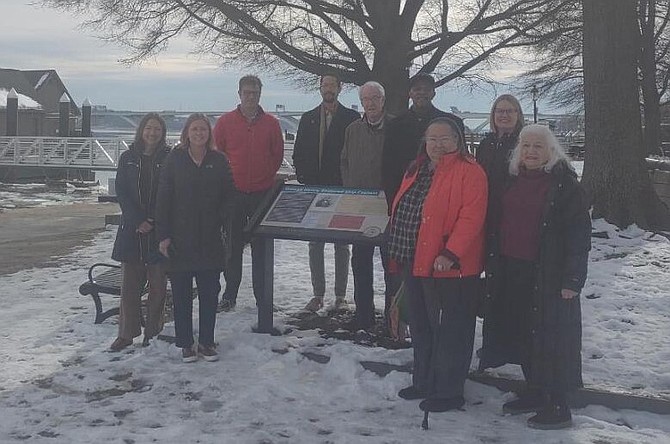Members of the African American Heritage Trail committee pose for a photo at one of the new historical marks along the waterfront. Shown are Emma Richardson, Eleanor Breen, Ben Skolnik, Blake Wilson, Ted Pulliam, McArthur Myers, Audrey Davis, Krysten Moon and Susan Cohen.
To many, Alexandria is known primarily as the hometown of George Washington. But there is also the city’s more complicated history as home to Robert E. Lee, slavery and segregation.
Thanks to the work of city historians and dedicated volunteers, a fuller history is being told of the city that was also known as a thriving slave trading port and where thousands of African Americans sought to flee the bondage of slavery in the south during the Civil War.
As Black History Month begins, the African American Heritage Trail Committee will mark the installation of new interpretive signs detailing this history along the southern waterfront with a ribbon cutting ceremony Feb. 10 at Founders Park.
Eleven signs and two orientation panels detail the history of the African American community in Alexandria. The event will begin at 11 a.m. at the new Fishtown sign on the river side of Founders Park. A reception following the ribbon cutting will be held in the Overlook Room (#325) on the third floor of the Torpedo Factory. The public is encouraged to attend.
“We envision the African American Heritage Trail as consisting of several interconnecting routes across the City of Alexandria,” according to the information website. “Together, these trails illuminate the history of the African American community over a span of several centuries. This trail highlights the contributions of Black Alexandrians, free and enslaved, to the history of Alexandria’s waterfront. We strive to forefront their experiences while recognizing that their voices are often not directly preserved in the historical record.”
 Franklin & Armfield's Slave Prison, from the anti-slavery broadside Slave Market of America, 1836.
Franklin & Armfield's Slave Prison, from the anti-slavery broadside Slave Market of America, 1836.
Stops on the new tour include a marker on the life of George Henry, the enslaved captain of the schooner Llewelyn, which was partially owned by an Alexandrian. Henry wrote an account of his life published 50 years later.
Another stop details the history of the River Queen, a sidewheel steamboat, docked at a wharf on Prince Street. Built in 1864, it had first gained fame as the site of an unsuccessful peace conference between President Abraham Lincoln and representatives of the Confederacy. By the end of the century, owners remodeled the steamer for day-long excursions that catered to African American pleasure seekers.
The new South Trail Route is the second in a series of trails covering the waterfront. The African American Heritage Trail Committee created the walking tours with the support of the Office of Historic Alexandria.
Members of the African American Heritage Trail Committee include: Susan Cohen, Gwen Day-Fuller, Krystyn Moon, McArthur Myers, Ted Pulliam, Eleanor Breen, Emma Richardson, Ben Skolnik, Blake Wilson and Audrey Davis.
The newly unveiled Southern Trail is a relatively flat walk along the waterfront from the foot of King Street to Jones Point, a little over two miles in distance. The trail mostly follows level, paved surfaces, but there are some areas of moderate slope, gravel paths and stairs. Included are alternate paths. The walking tour should take about an hour and a half at a leisurely pace. The walk back from the end of the trail is a little more than a mile, so plan accordingly or arrange for transportation from Jones Point.
Information and maps on both the North and South routes can be found at www.alexandriava.gov/historic-sites/african-american-heritage-trails
